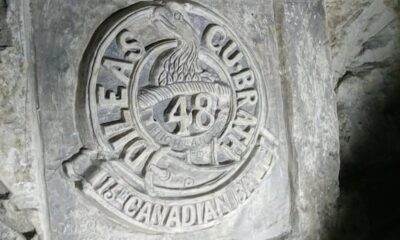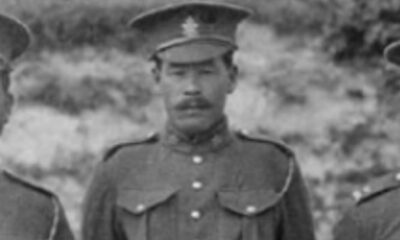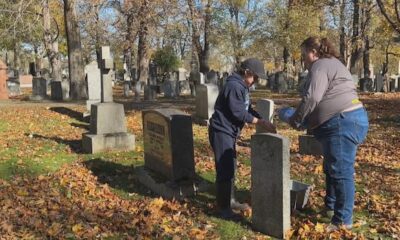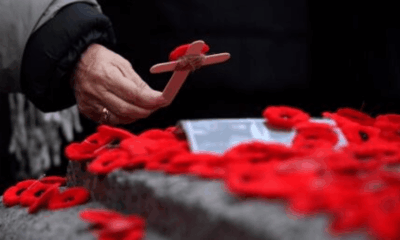Lifestyle
Calligrapher William Baldwin: From Remembrance to War Hero
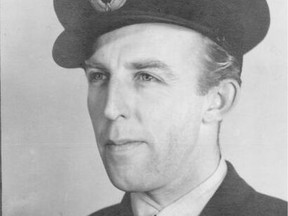
Canadian calligrapher William Baldwin dedicated five years to inscribing the names of every Canadian soldier who died during the First World War. From 1932 to 1937, he meticulously crafted the names, ranks, decorations, and units of 66,655 fallen servicemen onto handmade vellum. His work culminated in the creation of Canada’s first Book of Remembrance, a tribute that would later bear his own name.
Baldwin, a skilled commercial artist, was selected for this monumental task due to his precise and expressive handwriting. Each name required careful attention; a single error could undo weeks of labor. The finished book, comprising over 600 pages, featured elaborate illustrations and was bound in luxurious Moroccan leather, symbolizing the solemnity of the sacrifice made by Canadian soldiers.
Tragically, Baldwin’s life was cut short just nine months after the First World War Book of Remembrance was dedicated on November 11, 1942. He died when his bomber was shot down over Berlin at the age of 33. His name is now inscribed in Canada’s second Book of Remembrance, which honors those who served in the Second World War.
A Life Dedicated to Art and Service
Born on January 12, 1910, in Ottawa, Baldwin was raised in a family that valued craftsmanship. His father worked as a chief mechanic in the federal government’s printing bureau, which likely influenced Baldwin’s early interest in art and design. He attended Glebe Collegiate Institute, where he excelled in sports and developed a passion for mapping and artistry.
After leaving school at 18, Baldwin held various jobs, including a position in the photographic section of the Royal Canadian Air Force. In 1932, he was chosen to collaborate on the Book of Remembrance, a project initiated when planners realized there was insufficient space to engrave names in the walls of the Peace Tower’s Memorial Chamber. Colonel Archer Fortescue Duguid, the official historian for the Canadian Expeditionary Force, proposed the idea of a memorial book.
The project was led by artist James Purves, who enlisted Baldwin after evaluating his writing samples. Baldwin’s expertise in Roman lettering was deemed suitable for the task. Working in a specially outfitted office, he transcribed names from a list compiled by the National Defence Department. While many names were accurately recorded, there were inevitably omissions; an addendum was later created to correct these oversights.
Reflecting on Baldwin’s painstaking task, graphic designer and historian Dave O’Malley remarked, “I can’t help but wonder about what Baldwin thought as he transcribed each name, rank and unit. Did he wonder who these men and women were? Where they lived? Their families? Their futures?”
A Hero’s Journey in the Skies
The completion of the Book of Remembrance took longer than anticipated, ultimately spanning ten years and exceeding the original budget of $35,000. By the time it was publicly displayed in the Memorial Chamber on November 11, 1942, Baldwin had already enlisted in the RCAF in May 1940 as World War II intensified across Europe.
Baldwin volunteered to be an air gunner or navigator and eventually trained in navigation, although he faced challenges in mastering the role. He was assigned to 405 Squadron and flew his first combat mission over occupied Belgium in October 1941. His missions included bombing raids over major German cities and participation in the first “thousand bomber raid” on May 31, 1942, targeting Cologne.
By October 1942, Baldwin had completed a full tour of duty, which included 32 missions, earning a Distinguished Flying Cross for his exceptional navigation skills and inspiring demeanor. His citation praised his “unfailing cheerfulness and optimism, in spite of all hazards.”
Despite the option to take a desk job after his service, Baldwin chose to return to combat. However, during a raid on Berlin on August 23, 1943, his Halifax bomber was shot down by a Luftwaffe fighter. Although he managed to parachute from the aircraft, he did not survive the jump and was buried in the Berlin War Cemetery.
Baldwin’s legacy is twofold. He not only memorialized the names of those who made the ultimate sacrifice in the First World War but became one of them himself in the Second World War. His story serves as a poignant reminder of the personal sacrifices made by individuals during times of conflict, echoing through history in the pages of Canada’s Books of Remembrance.
-

 World4 months ago
World4 months agoScientists Unearth Ancient Antarctic Ice to Unlock Climate Secrets
-

 Politics5 days ago
Politics5 days agoSecwepemc First Nation Seeks Aboriginal Title Over Kamloops Area
-

 Entertainment4 months ago
Entertainment4 months agoTrump and McCormick to Announce $70 Billion Energy Investments
-

 Lifestyle4 months ago
Lifestyle4 months agoTransLink Launches Food Truck Program to Boost Revenue in Vancouver
-

 Science4 months ago
Science4 months agoFour Astronauts Return to Earth After International Space Station Mission
-

 Technology2 months ago
Technology2 months agoApple Notes Enhances Functionality with Markdown Support in macOS 26
-

 Top Stories1 month ago
Top Stories1 month agoUrgent Update: Fatal Crash on Highway 99 Claims Life of Pitt Meadows Man
-

 Sports4 months ago
Sports4 months agoSearch Underway for Missing Hunter Amid Hokkaido Bear Emergency
-

 Politics3 months ago
Politics3 months agoUkrainian Tennis Star Elina Svitolina Faces Death Threats Online
-

 Politics4 months ago
Politics4 months agoCarney Engages First Nations Leaders at Development Law Summit
-

 Technology4 months ago
Technology4 months agoFrosthaven Launches Early Access on July 31, 2025
-

 Top Stories3 weeks ago
Top Stories3 weeks agoFamily Remembers Beverley Rowbotham 25 Years After Murder



